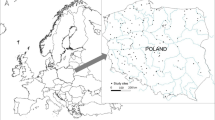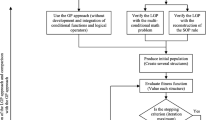Abstract
Rivers, as one of the crucial components of water resources, play a substantial role in human life. Due to a wide range of water consumptions, water quality is emphatically recommended assigning at a permissible level. Enormous field investigations have been carried out to quantify indicators of water quality parameters which have a great impact on the water quality. In this way, there are not explicit equations to predict WQPs with an allowable degree of accuracy. In the present work, gene expression programming (GEP), evolutionary polynomial regression (EPR), and model tree (MT) have been employed to estimate three indices including biochemical oxygen demand (BOD), dissolved oxygen, and chemical oxygen demand (COD). To develop the proposed models, nine input parameters \({\text{Ca}}^{2 + }\), \({\text{Na}}^{ + }\), \({\text{Mg}}^{2 + }\), \({\text{NO}}_{2}^{ - }\), \({\text{NO}}_{3}^{ - }\), \({\text{PO}}_{4}^{3 - }\), \({\text{EC}}\), \({\text{PH}}\), and \({\text{turbidity}}\) were selected as effective variables. Results of training and testing stages for these approaches have been investigated. Performance of the models indicated that the relative superiority of the EPR approach compared to the GEP and MT models. Gamma test was applied to determine important parameters for predicting BOD, COD, and COD indices. It was found that \({\text{PO}}_{4}^{3 - }\), \({\text{Ca}}^{2 + }\), and pH have the most significant effect on BOD, COD, and COD, respectively.










Similar content being viewed by others
References
Avila R, Horn B, Moriaty E, Hodson R, Moltchanova E (2018) Evaluating statistical model performance in water quality prediction. J Environ Manag 206:910–919
Ay M, Kisi O (2012) Modeling of dissolved oxygen concentration using different neural network techniques in Foundation Creek, El Paso County, Colorado. J Environ Eng 138(6):654–662
Agalbjorn S, Koncar N, Jones AJ (1997) A note on the gamma test. Neural Comput Appl 5(3):131–133
Barca E, Berardi L, Laucelli DB, Passarella G, Giustolisi O (2015) Evolutionary polynomial regression application for missing data handling in meteo-climatic gauging stations. Università degli studi di Bergamo. GRASPA WORKING PAPERS, pp 1–4
Basant N, Gupta S, Malik A, Singh KP (2010) Linear and nonlinear modeling for simultaneous prediction of dissolved oxygen and biochemical oxygen demand of the surface water—a case study. Chemom Intell Lab Syst 104(2):172–180
Bozorg-Haddad O, Soleimani S, Loáiciga HA (2017) Modeling water-quality parameters using genetic algorithm-least squares support vector regression and genetic programming. J Environ Eng 143(7):04017021
Carbone M, Berardi L, Laucelli D, Piro P (2012) Data-mining approach to investigate sedimentation features in combined sewer overflows. J Hydroinf 14(3):613–627
Chaves P, Kojiri T (2007) Conceptual fuzzy neural network model for water quality simulation. Hydrol Process 21:634–646
Cox BA (2003) A review of dissolve oxygen modeling techniques for lowland rivers. The Sci Total Environ 314–316:303–334
Creaco E, Berardi L, Sun S, Giustolisi O, Savic D (2016) Selection of relevant input variables in storm water quality modeling by multiobjective evolutionary polynomial regression paradigm. Water Resour Res 52:2403–2419
Diamantopoulou MJ, Papamichail DM, Antonopoulos VZ (2005) The use of a neural network technique for the prediction of water quality parameters. Oper Res Int J 5(1):115–125
Dogan E, Sengorur B, Koklu R (2009) Modeling biological oxygen demand of the Melen River in Turkey using an artificial neural network technique. J Environ Manag 90(2):1229–1235
Ebtehaj I, Bonakdari H, Zaji AH, Azimi H, Sharifi A (2015) Gene expression programming to predict the discharge coefficient in rectangular side weirs. Appl Soft Comput 35:618–628
Emamgholizadeh S, Kashi H, Marofpoor I, Zalaghi E (2014) Prediction of water quality parameters of Karoon River (Iran) by artificial intelligence-based models. Int J Environ Sci Technol 11(3):645–656
Etemad-Shahidi A, Taghipour M (2012) Predicting longitudinal dispersion coefficient in natural streams using M5′ model tree. J Hydraul Eng ASCE 138(6):542–554
Etemad-Shahidi A, Ghaemi N (2011) Model tree approach for prediction of pile groups scour due to waves. Ocean Eng 38:1522–1527
Falconer RA, Liu S (1995) Mathematical modeling of water quality processes using higher-order accurate schemes. Environ Int 21(2):111–122
Ferreira C (2001) Gene expression programming: a new adaptive algorithm for solving problems. Complex Syst 13(2):87–129
Ferreira C (2002) Gene expression programming in problem solving. In: Roy R, Köppen M, Ovaska S, Furuhashi T, Hoffmann F (eds) Soft computing and industry. Springer, Berlin, pp 635–653
Faruk DO (2010) A hybrid neural network and ARIMA model for water quality time series prediction. Eng Appl Artif Intell 23:586–594
Gandomi AH, Babanajad SK, Alavi AH, Farnam Y (2012) Novel approach to strength modeling of concrete under triaxial compression. J Mater Civ Eng 24(9):1132–1143
Gandomi AH, Alavi AH, Gandomi M, Kazemi S (2017) Formulation of shear strength of slender RC beams using gene expression programming, part II: with shear reinforcement. Measurement 95:367–376
Gazzaz NM, Yusoff MK, Aris AZ, Juahir H, Ramli MF (2012) Artificial neural network modeling of the water quality index for Kinta River (Malaysia) using water quality variables as predictors. Mar Pollut Bull 64:2409–2420
Ghavidel SZZ, Montaseri M (2014) Application of different data-driven methods for the prediction of total dissolved solids in the Zarinehroud basin. Stoch Environ Res Risk Assess 28(8):2101–2118
Giustolisi O, Savic DA (2006) A symbolic data-driven technique based on evolutionary polynomial regression. J Hydroinf IWA 8(3):207–222
Giustolisi O, Savic DA (2009) Advances in data-driven analyses and modelling using EPR-MOGA. J Hydroinf 11(3–4):225–236
Gray AV, Li W (1999) Case study on water quality modeling of Dianchi lake, Yunnan province, Sout West China. Water Sci Technol 40(2):35–43
Hameed M, Sharqi SS, Yaseen ZM, Afan HA, Hussain A, Elshafie A (2017) Application of artificial intelligence (AI) techniques in water quality index prediction: a case study in tropical region, Malaysia. Neural Comput Appl 28(1):893–905
Heddam S, Kisi O (2018) Modelling daily dissolved oxygen concentration using least square support vector machine, multivariate adaptive regression splines and M5 model tree. J Hydrol 559:499–509
Khan M, Tufail M, Azamathulla HM, Ahmad I, Muhammad N (2018) Genetic functions-based modelling for pier scour depth prediction in coarse bed streams. Paper presented at the Proceedings of the Institution of Civil Engineers-Water Management
Kisi O, Akbari N, Sanatipour M, Hashemi A, Teimourzadeh K, Shiri J (2013) Modeling of dissolved oxygen in river water using artificial intelligence techniques. J Environ Inf 22(2):92–101
Kisi O, Keshavarzi A, Shiri J, Zounemat-Kermani M, Omran E-SE (2017) Groundwater quality modeling using neuro-particle swarm optimization and neuro-differential evolution techniques. Hydrol Res 48(6):1508–1519
Koncar N (1997) Optimisation methodologies for direct inverse neurocontrol, Ph.D. thesis. Department of Computing, Imperial College of Science, Technology and Medicine, University of London
Laucelli D, Giustolisi O (2011) Scour depth modelling by a multi-objective evolutionary paradigm. Environ Model Softw 26(4):498–509
Laucelli D, Romano M, Savić D, Giustolisi O (2016) Detecting anomalies in water distribution networks using EPR modelling paradigm. J Hydroinf 18(3):409–427
Maier HR, Dandy GC (1996) The use of artificial neural networks for the prediction of water quality parameters. Water Resour Res 32(4):1013–1022
Mannina G, Viviani G (2010) Water quality modeling for ephemeral rivers: model development and parameter assessment. J Hydrol 393(3–4):186–196
Martí P, Shiri J, Duran-Ros M, Arbat G, De Cartagena FR, Puig-Bargués J (2013) Artificial neural networks vs. gene expression programming for estimating outlet dissolved oxygen in micro-irrigation sand filters fed with effluents. Comput Electron Agric 99:176–185
Najah A, Elshafie A, Karim OA, Jaffar O (2009) Prediction of Johor River water quality parameters using artificial neural networks. Eur J Sci Res 28(3):422–435
Nguyen TT, Keupers I, Willems P (2018) Conceptual river water quality model with flexible model structure. Environ Model Softw 104:102–117
Noori R, Karbassi A, Sabahi MS (2010) Evaluation of PCA and Gamma test techniques on ANN operation for weekly solid waste prediction. J Environ Manag 91(3):767–771
Noori R, Karbassi A, Moghaddamnia A, Han D, Zokaei-Ashtiani M, Farokhnia A, Gousheh MG (2011) Assessment of input variables determination on the SVM model performance using PCA, Gamma test, and forward selection techniques for monthly stream flow prediction. J Hydrol 401(3):177–189
Orouji H, Bozorg Haddad O, Fallah-Mehdipour E, Mariño M (2013) Modeling of water quality parameters using data-driven models. J Environ Eng 139(7):947–957
Pal M, Singh NK, Tiwari NK (2012) M5 model tree for pier scour prediction using field dataset. KSCE J Civ Eng 16(6):1079–1084
Paliwal R, Sharma P, Kansal A (2007) Water quality modeling of the river Yamuna (India) using QUAL2E-UNCAS. J Environ Manag 83(2):131–144
Park SS, Lee YS (2002) A water quality modeling study of the Nakdong River, Korea. Ecol Model 152(1):65–75
Quinlan JR (1992) Learning with continuous classes. In: Proceedings of the Fifth Australian Joint Conference on Artificial Intelligence. World Scientific, pp 343–348
Rajaee T, Shahabi A (2016) Evaluation of wavelet-GEP and wavelet-ANN hybrid models for prediction of total nitrogen concentration in coastal marine waters. Arab J Geosci 9(3):176
Ravansalar M, Rajaee T (2015) Evaluation of wavelet performance via an ANN-based electrical conductivity prediction model. Environ Monit Assess 187(6):366. https://doi.org/10.1007/s10661-015-4590-7
Ravansalar M, Rajaee T, Zounemat-Kermani M (2016a) A wavelet–linear genetic programming model for sodium (Na+) concentration forecasting in rivers. J Hydrol 537:398–407
Ravansalar M, Rajaee T, Ergil M (2016b) Prediction of dissolved oxygen in River Calder by noise elimination time series using wavelet transform. J Exp Theor Artif Intell 28(4):689–706
Remesan R, Shamim M, Han D (2008) Model data selection using gamma test for daily solar radiation estimation. Hydrol Process 22(21):4301–4309
Rezaei-Balf MR, Noori R, Berndtsson R, Ghaemi A, Ghiasi B (2018) Evolutionary polynomial regression approach to predict longitudinal dispersion coefficient in rivers. J Water Supply Res Technol-Aqua 67:447–457
Roushangar K, Mehrabani FV, Shiri J (2014) Modeling river total bed material load discharge using artificial intelligence approaches (based on conceptual inputs). J Hydrol 514:114–122
Savic D, Giustolisi O, Laucelli D (2009) Asset deterioration analysis using multi-utility data and multi-objective data mining. J Hydroinf 11(3–4):211–224
Shiri J, Marti P, Singh VP (2014) Evaluation of gene expression programming approaches for estimating daily evaporation through spatial and temporal data scanning. Hydrol Process 28(3):1215–1225
Shiri J, Keshavarzi A, Kisi O, Karimi S (2017) Using soil easily measured parameters for estimating soil water capacity: soft computing approaches. Comput Electron Agric 141:327–339
Šiljić A, Antanasijević D, Perić-Grujić A, Ristić M, Pocajt V (2015) Artificial neural network modelling of biological oxygen demand in rivers at the national level with input selection based on Monte Carlo simulations. Environ Sci Pollut Res 22(6):4230–4241
Singh KP, Basant A, Malik A, Jain G (2009) Artificial neural network modeling of the river water quality-a case study. Ecol Model 220(6):888–895
Soltani F, Kerachian R, Shirangi E (2010) Developing operating rules for reservoirs considering the water quality issues: application of ANFIS-based surrogate models. Expert Syst Appl 37(9):6639–6645
Soyupak S, Karaer F, Gürbüz H, Kivrak E, Sentürk E, Yazici A (2003) A neural network-based approach for calculating dissolved oxygen profiles in reservoirs. Neural Comput Appl 12(3–4):166–172
Tomić ANŠ, Antanasijević DZ, Ristić MĐ, Perić-Grujić AA, Pocajt VV (2016) Modeling the BOD of Danube River in Serbia using spatial, temporal, and input variables optimized artificial neural network models. Environ Monit Assess 188(5):300
Verma A, Singh T (2013) Prediction of water quality from simple field parameters. Environ Earth Sci 69(3):821–829
Zhao L, Li Y, Zou R, He B, Zhu X, Liu Y, Wang J, Zhu Y (2013) A three-dimensional water quality modeling approach for exploring the eutrophication responses to load reduction scenarios in Lake Yilong (China). Environ Pollut 177:13–21
Wang Y, Witten IH (1997). Induction of model trees for predicting continuous classes. In: Proceedings of the Poster Papers of the European conference on machine learning. University of Economics, Faculty of Informatics and Statistics, Prague
Acknowledgments
The authors wish to thank all who assisted in conducting this work.
Author information
Authors and Affiliations
Corresponding author
Additional information
Editorial responsibility: Binbin Huang.
Electronic supplementary material
Below is the link to the electronic supplementary material.
Rights and permissions
About this article
Cite this article
Najafzadeh, M., Ghaemi, A. & Emamgholizadeh, S. Prediction of water quality parameters using evolutionary computing-based formulations. Int. J. Environ. Sci. Technol. 16, 6377–6396 (2019). https://doi.org/10.1007/s13762-018-2049-4
Received:
Revised:
Accepted:
Published:
Issue Date:
DOI: https://doi.org/10.1007/s13762-018-2049-4




